
モルダバイト宝石:特性、意味、価値など
 モルダバイトは、地球と宇宙が共存するユニークな形態を持つ、希少な緑色のシリカガラスです。まるで宝石の宇宙飛行士のように、モルダバイトの宝石は地球から宇宙へ飛び立ち、そして再び地球へと落下してきたのです。
モルダバイトは、地球と宇宙が共存するユニークな形態を持つ、希少な緑色のシリカガラスです。まるで宝石の宇宙飛行士のように、モルダバイトの宝石は地球から宇宙へ飛び立ち、そして再び地球へと落下してきたのです。
モルダバイトは、強力なヒーリングクリスタルとして、また美しいアクセサリーや装飾品として知られています。しかし、モルダバイトは宝石なのでしょうか?
はい、モルダバイトは宝石とみなされます。宝石は一般的にクリスタルと考えられていますが、モルダバイトはクリスタルではありませんが、他のクリスタル宝石と同様に使用されます。
実は、モルダバイトは地球上で最も希少な宝石の一つです!では、なぜモルダバイトは希少なのでしょうか?それは、その独特な起源と希少な産地にあります。今日はその詳細をご紹介します!
モルダバイトは購入する価値があるのでしょうか?この記事を読み終える頃には、モルダバイトの特性、用途、そしてパワーについて、ご自身で判断するために必要な情報をすべて理解できるはずです。

モルダバイト石について
モルダバイトは、オリーブグリーン、フォレストグリーン、イエローグリーン、そしてブラウングリーンといった色合いを持つ、まさに特別な宝石です。モルダバイトは宝石でしょうか?いいえ、モルダバイトは半貴石ですが、その希少性ゆえに貴重な商品となっています。
実は、ダイヤモンドの年間生産量は約30トンですが、モルダバイトはたったの300トン!つまり、モルダバイトは貴重な宝石であるダイヤモンドよりも希少なのです。
モルダバイトの別名は「ブテイユ石」です。ブテイユとはフランス語で「ボトル」を意味し、石のボトルグリーンの色に由来しています。
モルダバイトは毎月の誕生石ではありませんが、射手座の星座石です!モルダバイトを身に着けることで、射手座の人は、その開放的で好奇心旺盛な性質を開花させることができます!
弊社の販売員の一人luxuryopalseurope が鉱山から直接運ばれた素晴らしいモルダバイトの石を発見する様子をご覧ください。
鉱物の特性
モルダバイトはシリカと様々な酸化物(通常は酸化アルミニウム)で構成されています。希少ではあるものの、宝石質のテクタイト鉱物としては最も一般的なものです。テクタイト族は、隕石の衝突によって飛散した物質から形成された天然ガラスの小さなグループです。
色に関して言えば、宝石品質のモルダバイトは、濃い緑、オリーブグリーン、ターコイズ、あるいはシーグラスグリーンといった色をしています。茶色がかった緑色は、宝石には適さない素材によく見られます。
モース硬度スケールでは、モルダバイトは5~7と、平均的な耐久性を示すランクです。原石のモルダバイトの表面には、隕石に似た特徴的な窪みやシワが見られます。
モルダバイトは表面以外で本物かどうかを見分けるにはどうすればいいのでしょうか?モルダバイトの見分け方と見分け方を見ていきましょう。
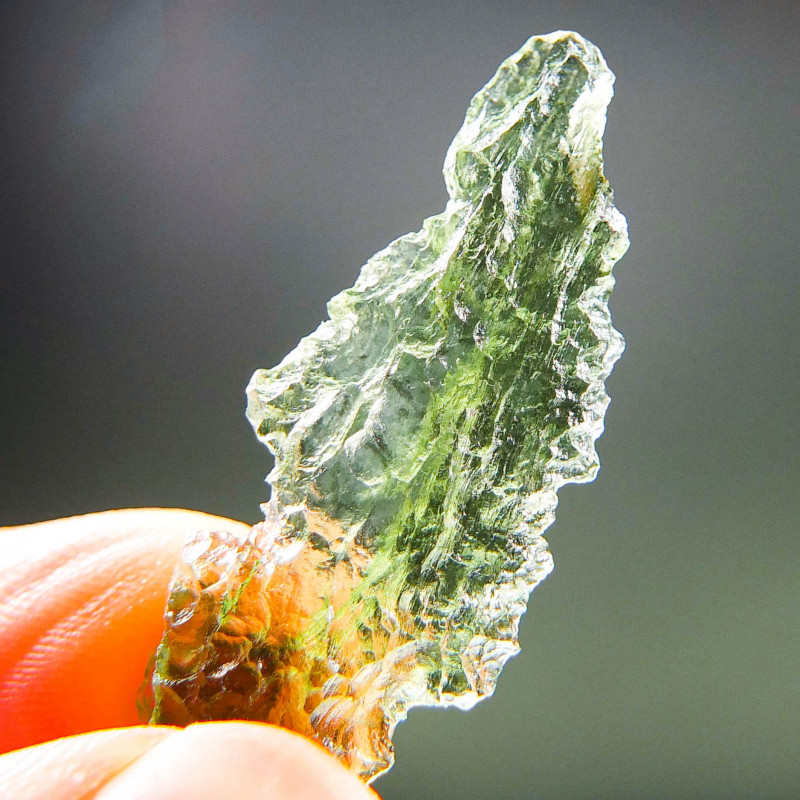
モルダバイトの見分け方:偽物と本物のモルダバイト
モルダバイトの視覚的な特徴としては、内包物と波打つ蒸気のような表面が挙げられます。最も顕著な特徴は、レシャテリエライトとガス泡の存在です。
しかし、モルダバイトは種類が異なります。石の内包物や蛍光X線を調べるのが安全ですが、適切な宝石鑑定機器が必要になる場合もあります。
偽モルダバイトは通常、人工的に作られた緑色のガラスです。これらの模造品は透明で内包物がなく、モルダバイトにしては「完璧」すぎるのです。
「アフリカ産モルダバイト」と書いてあっても、それはモルダバイトではありません。おそらくリビア砂漠ガラスかコートジボワール産テクタイトでしょう。
モルダバイトのその他の特性については以下をご覧ください。
モルダバイトの仕様と特徴
色: オリーブグリーン、黄緑、フォレストグリーン、または茶緑
結晶構造:なし(非晶質)
光沢:ガラス質(ガラスのような)
透明性:透明から不透明
屈折率:1.48~1.54
密度:2.32~2.38
胸の谷間:なし
骨折:貝殻状
縞模様:白
発光:あり;X線では黄緑色
鉱物の側面が終わったので、モルダバイトの形而上学的側面を探索してみましょう。
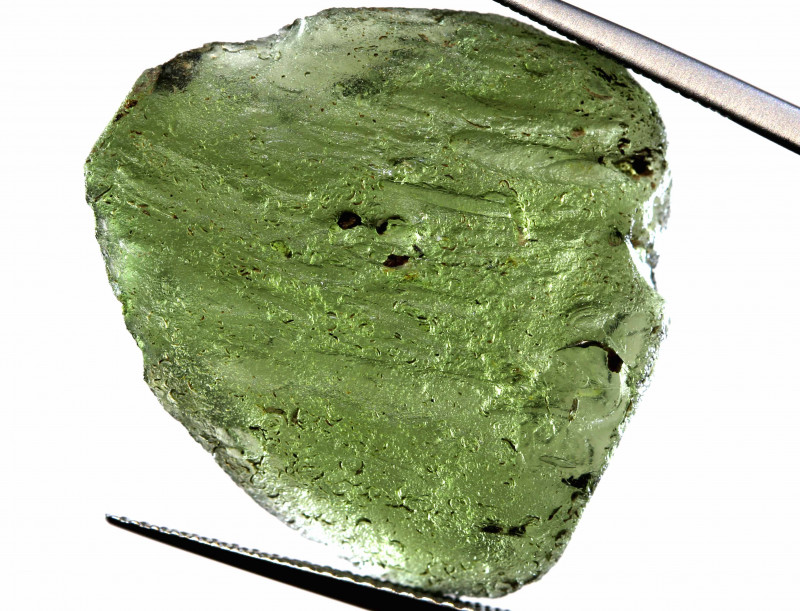
モルダバイトの意味
この宝石には、モルダバイトとヴルタヴィーンの2つの名前があります。これらの名前は、石の産地であるチェコ共和国、ヴルタヴァ川(チェコ語)またはモルダウ川(ドイツ語)に由来しています。
「モルダウ」と「ヴルタヴァ」はどちらも、おそらく古代ゲルマン語の「野生の水」を意味する wilt ahwa に由来しています。
スピリチュアルな観点から見ると、モルダバイトは繋がりと変容を象徴します。この石は、あなたの視点を一変させる、人生を変えるほどの力強い変化を象徴しています。
モルダバイトのもう一つのスピリチュアルな関連性は、不死鳥です。灰から蘇る不死鳥のように、モルダバイトは火(隕石衝突時に溶解した堆積物)によって形成され、再生(大気圏に投げ出され、再び落下すること)を経験しました。
サンスクリット語でモルダバイトは「アグニ・マニ」 、つまり「火の真珠」を意味します。著名な神秘主義者ニコライ・レーリヒは、モルダバイトとチベットで最も神聖な宝石であるシャンバラの石との関係を初めて説明しました。
レーリヒはまた、モルダバイトが聖杯に使われていた可能性が高いと主張した。聖杯とは、中世文学でよく知られる神話上の杯(伝説によっては皿や宝石)である。この杯には、キリストの血を受け止めた、神と戦っているサタンの額(あるいは王冠)から落ちた、アーサー王伝説の騎士たちに治癒と若返りの力を与えたなど、様々な伝説がある。
チェコスロバキアの民間伝承には、この宇宙の宝石が幸運をもたらし、生殖能力を高め、結婚生活の調和を促進するという物語があります。
現在、モルダバイトのクリスタルヒーリングの効能は何でしょうか?
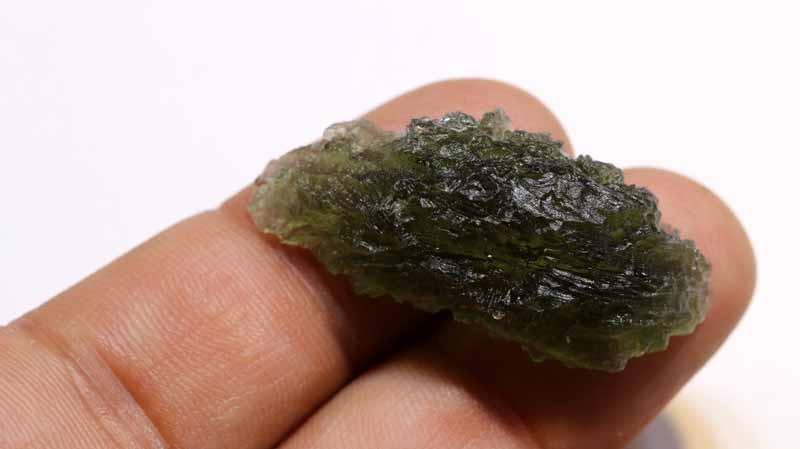
モルダバイトの治癒特性
宝石はその色彩と形状の性質から、ヒーリングストーンとして用いることができます。クリスタルヒーリングコミュニティでは、モルダバイトは、その高エネルギーの波動と変容の力から、最も人気のあるヒーリングストーンの一つです。
他の 緑色の宝石と同様に、モルダバイトの原石は、若返り、成長、そして新たな始まりをもたらします。クリスタルヒーラーは、変容をもたらすスピリチュアルな体験を求める方に、この石を推奨しています。
身体の治癒
肉体面では、モルダバイトは若返り効果が高く、肌や記憶力への老化の影響を軽減すると言われています。その他、慢性的な痛みの原因を解消し、視力を強化し、細胞の損傷を防ぐ効果も期待されています。
感情的な癒し
モルダバイトの感情面への効果としては、不安の軽減、心の平穏、感情のカタルシス促進などが挙げられます。自分の感情を言葉にしたり、書き記したりして解放することが、癒しへの第一歩です。
「つながりの石」であるモルダバイトは、人間関係の改善だけでなく、より良いコミュニケーションを促進することもできます。
チャクラヒーリング
チャクラヒーリングとは、肉体的、感情的、そして精神的な健康に繋がるエネルギーセンターである7つのチャクラのバランスを整えるプロセスです。最も簡単な方法はチャクラクリスタルを使うことです。モルダバイトは強力なハートチャクラストーンです。
ハートチャクラは、私たちがどのように愛し、変化にどう反応するかを司ります。もし感情が自分の中に閉じ込められ、他者との感情的な繋がりを断ち切っているように感じるなら、ハートチャクラが詰まっている可能性があります。
モルダバイトを使ってチャクラを再び開くと、傷つきやすくなり、オープンになり、人生で起こるあらゆる変化に対処する能力に自信を持てるようになります。
さて、購入したモルダバイト石に自信を持つためには、どのような特性を注目するべきかを知っておくことが最善です。
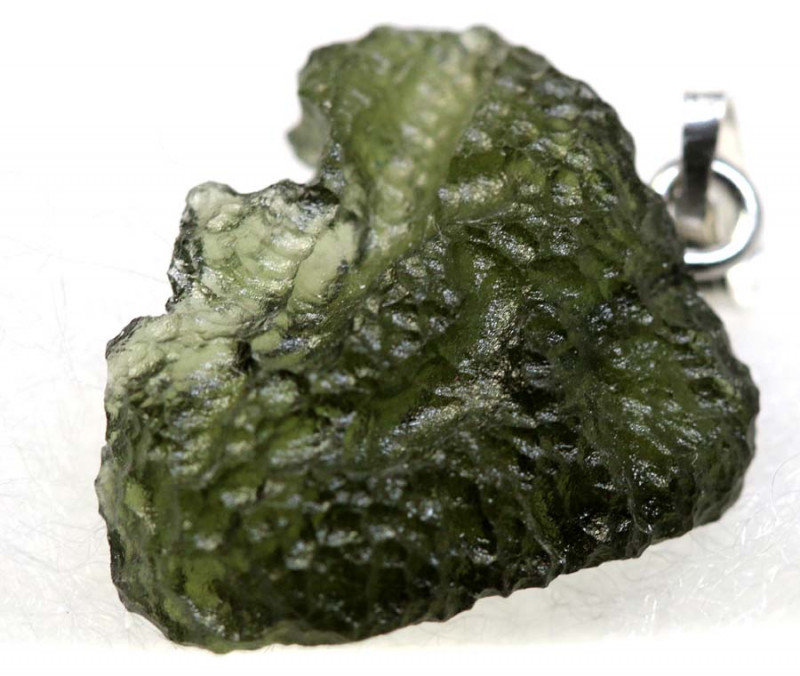
モルダバイト宝石の特性
宝石の専門家は、石の宝石特性に基づいて客観的な価値を判断します。偽物が多いことを考えると、モルダバイトは鑑定書付きのものを選ぶことをお勧めします。
認定されたモルダバイトには、サイズ、色、カット、特別な属性などの特性が記載された、評判の良い組織 (国際隕石収集家協会など) からの真正証明書が付いています。
一般的に、モルダバイトには 2 つのグレードがあります。
レギュラーグレード: 風化や穴あきにより表面が暗く、彩度の高い緑色になっています。
高品質(美術館級) :苔のような模様と高い透明度を持ちます。
モルダバイトの価値は、グレード以外に何によって決まるのでしょうか?モルダバイトの価値を決める主な要素は、何よりもまずカット、次に透明度、色、そしてカラット重量です。
色
モルダバイトはすべて緑色ですが、彩度には幅があり、黄色や茶色の基調がかすかに混ざることがあります。モルダバイトの緑色の原因は、鉄分の含有量が少ないことです。最も価値の高い色は、均一で鮮やかな色合いで、淡い色から中程度の彩度で、茶色の基調が全くありません。
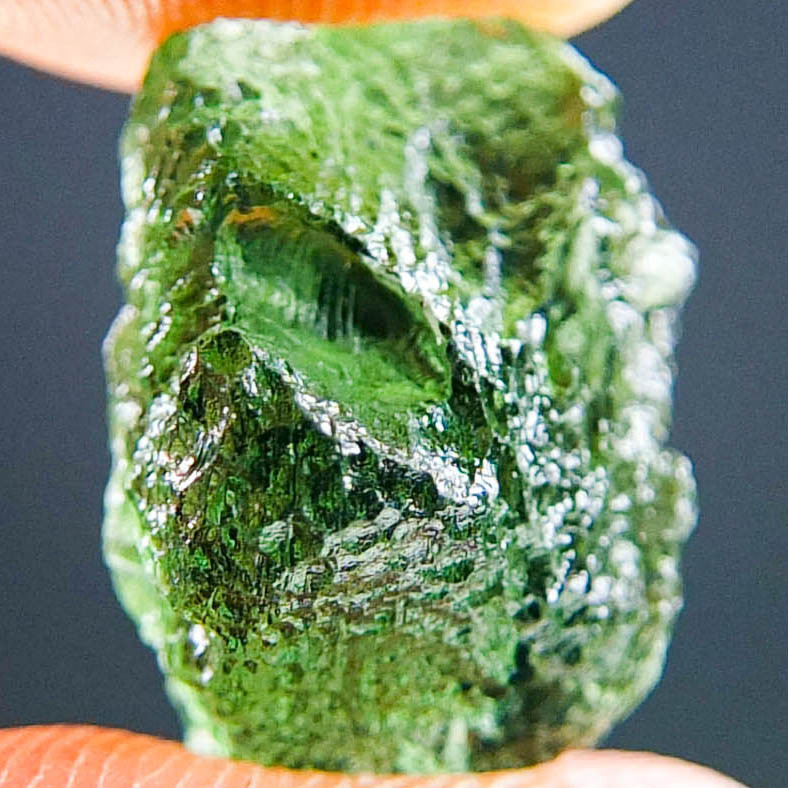
透明度と光沢
クラリティとは、宝石に含まれる内包物の量と視認性を指します。モルダバイトによく見られる内包物には、以下のようなものがあります。
レシャテリエライト: 隕石の衝突地点で溶融石英粒子から形成された天然シリカガラス。鋭い針金状の峰や虫のような包有物として見られます。
流動構造: 溶けた物質が固まる際にモルダバイトが急速な速度と回転で地球に落下したことを示す混沌とした縞模様または渦巻き。
ガス泡: 形成中に閉じ込められた球形、楕円形、またはレンズ状の泡で、本物のモルダバイトの良い指標となります。
モルダバイトの透明度はカット、ひいては価値に大きな影響を与えます。最も一般的なインクルージョンであるガス泡は、ファセット加工の際に容易に表面から抜け出し、価値を下げる可能性があります。
光沢は石の透明度を表します。モルダバイトの最高の光沢は透明ですが、これは非常に稀少です。ほとんどのモルダバイトは不透明であるため、半透明度が少しでも高ければ価値が高まります。
カット
モルダバイトの価値を決定づける最も重要な要素はカットですが、原石のモルダバイトも非常に価値があります。宝石職人は、 ファセットカット、あるいはカボションやビーズのようなファセットカットなしのカットを選択する場合があります。
モルダバイトの色を引き立てるために、一般的なファセットカットはラウンドカットまたはエメラルドカットです。他の宝石とは異なり、ファセットカットされたモルダバイトは、より粗いファセット面を呈します。
モルダバイトの原石は、カットされていないことも少なくありません。結晶のような形状は、特に「フラワーバースト」模様が特徴的なモルダバイトリングにおいて、独特の魅力を放ちます。原石は、ディスクやフィギュア、その他個性的な形に彫刻されることもあります。さらに、天然のモルダバイトは、ドロップ型、オーバル型、スパイラル型など、様々な形状を呈することもあります。
カラット重量
カラット重量は、他のすべての要素が同じ場合のみ、モルダバイトの価値にほとんど影響を与えません。販売されているモルダバイトのほとんどは1~19カラットで、平均は3~4カラットです。
知られている最大のモルダバイト標本の 1 つである「スラブ モルダバイト」は、重さ 1,327.5 カラット (265.5 グラム) あり、1971 年にモラビアで発見されました。これは、この石の歴史を物語っています。

モルダバイトの歴史
モルダバイトは、地質学者が現在のドイツのネルトリンガー・リースに隕石が衝突したと推測する1400万〜1500万年前に誕生しました。
考古学的証拠によれば、旧石器時代初期の人類はモルダバイトを使用し、取引し、道具、武器、お守り(ヴィレンドルフのヴィーナス像で発見されたものなど)を作っていたことがわかっています。
ヴィレンドルフのヴィーナスは、25,000年前に遡ると考えられている女神像として知られている最古の像の1つで、モルダバイトのネックレスに囲まれた状態で1908年に発見されました。
中世では、この石は非常に尊崇されていたため、モルダバイトの宝飾品を身に着けることができたのは王族や貴族だけでした。
モルダバイトの最初の公式な発見は1787年、ヨーゼフ・マイヤーがボヘミアのヴルタヴァ川でモルダバイトを発見した時でした。マイヤーはそれをクリソライトだと考え、ボヘミア科学協会にそのように提出しました。
モルダバイトという名前は、1836年に博物館学芸員のFXMジッペによって選ばれました。
しかし、この石の真の起源は1900年、FE・スースが、地球外ではあるものの隕石のような表面の凹凸を発見するまで明らかにされませんでした。スースはモルダバイトが隕石の一種であると信じていましたが、彼の分析は最終的に科学者たちに、今日私たちが知っている形成過程の理論を導き出しました。
1900年代を通じて、この石はスイス政府からエリザベス2世女王に贈られたモルダバイトのネックレスなど、注目を集めました。
この魅力的な歴史を歩む前、モルダバイトはどのようにして形成されたのでしょうか?その答えは、この世のものとは思えないほど驚くべきものです!
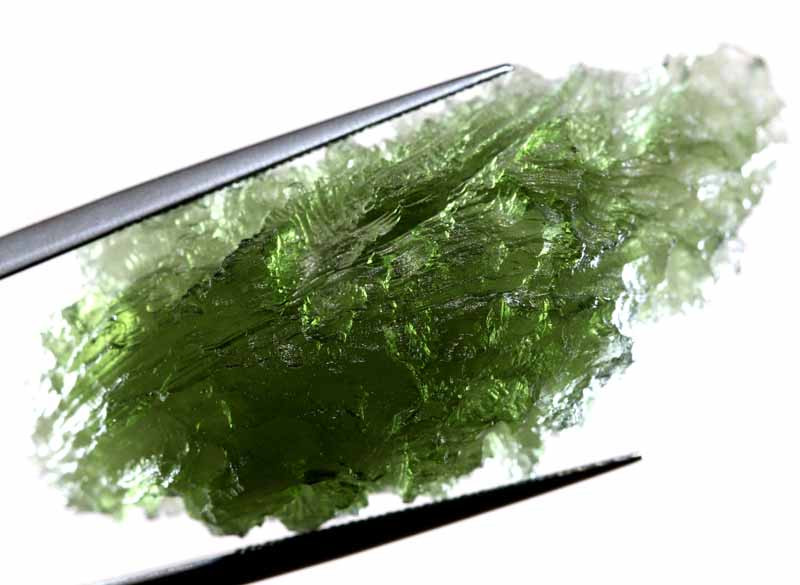
モルダバイトの起源と産地
モルダバイトは、隕石が地球に衝突し、溶融した物質が大気圏に舞い上がったことで形成されました。上昇したものは必ず下降し、その物質は渦を巻きながら新たな形へと変化し、再び地球に降り注ぎ、あちこちに散らばっています。
化学的に言えば、隕石が衝突したとき、モルダバイトの前身物質は蒸発し、液体に凝縮し、その後ガラスに固まりました。これは、他の宝石が何年も何世紀もかけて形成されるよりもはるかに速いのです。
でも、モルダバイトはどこでも手に入るわけではありません。では、モルダバイトはどこの国から来たのでしょうか?
採掘場所
隕石はドイツに落下しましたが、モルダバイトは本物のモルダバイトの唯一の産地であるチェコ共和国中に散らばりました。
チェコ共和国には、モルダバイトの主な産地がボヘミアとモラビアの2つあります。ボヘミアにはモルダバイトの99%が産出され、宝石品質の標本はボヘミア産のみです。残りの1%は、茶色がかった緑色で球形に近いものが多く、モラビア産と近隣のオーストリア、ドイツ産です。
ショッピング中に、「なぜ今モルダバイトはこんなに高いの?」と疑問に思うかもしれません。供給量が限られているため、価格は今後も上昇する可能性が高いため、良い投資となるでしょう。

モルダバイトの価格と価値
モルダバイトは希少性を考えると、実のところ比較的安価です。では、モルダバイトの1グラムあたりの価格はいくらでしょうか?品質、特にカットによって大きく異なります。
通常グレードの原石モルダバイトは通常 1 グラムあたり 15 ~ 25 ドル (1 カラットあたり 3 ~ 5 ドル) ですが、表面にひび割れがない場合は 1 グラムあたり 30 ドル (1 カラットあたり 6 ドル) になることもあります。
博物館級のモルダバイトは、サイズに関わらず、300ドルから数十万ドルまでの価格が付けられます。20カラット前後で色の良いモルダバイト原石は、通常1個100ドルから300ドルです。
低品質のモルダバイト(20カラット未満)の1カラットあたりの価格は、通常8~15ドルです。しかし、モルダバイトビーズ1個あたり60~80ドルになることもあり、1連で約1,200~1,400ドルになります。
モルダバイトのケアとメンテナンス
モルダバイトは着用しにくいため、保護セッティングが施されたモルダバイトジュエリーの購入をお勧めします。強い衝撃から守るため、モルダバイトリングよりもネックレスやイヤリングの方が安全です。
モルダバイトは防水ですか?はい、濡れても大丈夫です!
モルダバイトは柔らかいブラシ、中性洗剤、ぬるま湯で丁寧に洗い、マイクロファイバークロスで乾かしてください。超音波洗浄機、スチームクリーナー、刺激の強い化学薬品、熱は避けてください。
モルダバイトは布で包み、柔らかい箱に入れて他の宝石から離して保管してください。箱は不透明で乾燥した、直射日光の当たらない場所に保管してください。
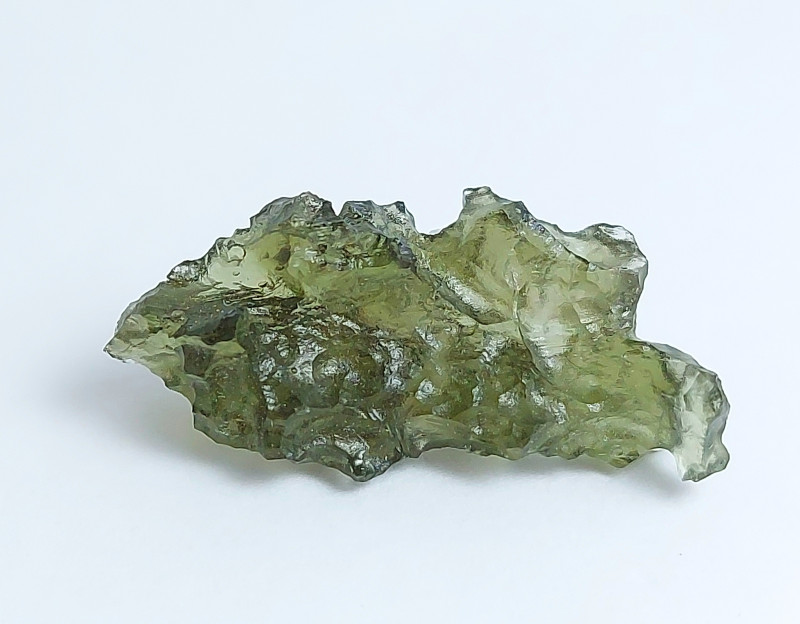
モルダバイトで型を破ろう!
ここまでで、モルダバイトという宝石についてすべてご理解いただけたと思います。では、モルダバイトは購入すべきでしょうか? 私たちの意見では、この石の唯一無二の起源、外観、そしてパワーは、どんなコレクションにも欠かせないものです! 結局のところ、宇宙を旅して戻ってきた宝石を身に着けていると言える機会はどれほどあるでしょうか?
モルダバイトをどこで購入するかを決めるときは、本物を確実に手に入れるために、厳格な検証プロセスを備えた評判の良い販売者を見つけることが重要です。
Gemstone Encyclopedia検索
最新記事
レインボーラティスサンストーンは、様々な内包物によって3つのゴージャスな光学的効果を持つ長石の一種です。燃えるように鮮やかな色合いと格子模様が、コレクターにとって希少な宝石となっています。
12th Jan 2026
チューライトは、ゾイサイト鉱物ファミリーに属する、鮮やかなバラ色の色合いを示す希少なノルウェー産の宝石で、ジュエリーのセッティングやペンダントによく使用されます。
6th Jan 2026
記事のカテゴリ
How To's is where you will find helpful articles from gem Rock Auctions on how to cut gemstones, select gemstones and buy gemstones.
9記事数

